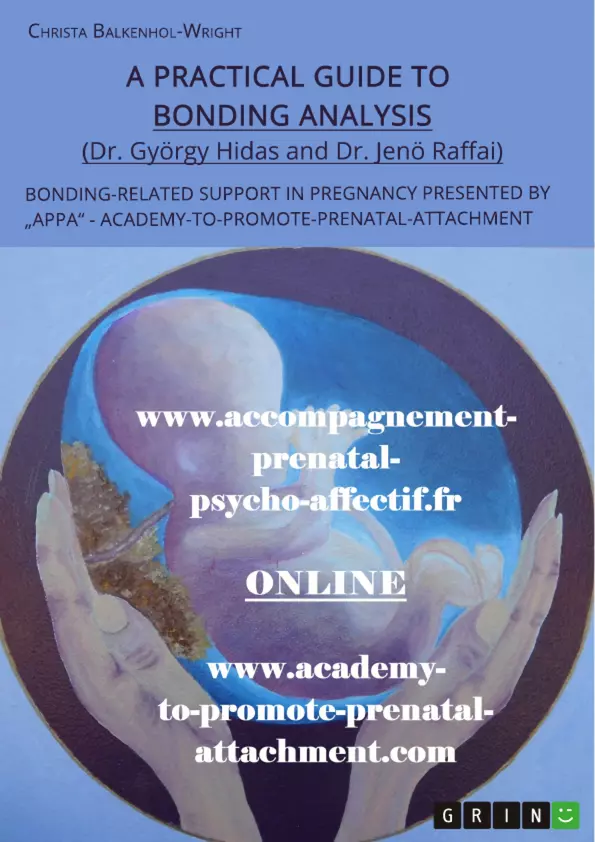This practical guide presents BONDING ANALYSIS, a method developed by two Hungarian psychoanalysts, Dr. György Hidas and Dr. Jenö Raffai, that enables pregnant women to establish mental and emotional contact with their baby and to further develop and deepen this contact throughout the course of pregnancy.
It is through prenatal bonding that the pregnant woman has the chance to play an important role in contributing to her baby's psychological and physical healthy development in utero. The significance of prenatal bonding has been worked out by experts in prenatal psychology, such as Dr. Thomas Verny, Dr. David Chamberlain and Dr. Ludwig Janus, to name but a few.
One of the findings of prenatal psychology is the proven fact that everything the pregnant woman does, thinks, feels is being transmitted to her baby via different communication channels and everything the unborn baby experiences is stored as a memory in all its cells.
BONDING ANALYSIS is a preventive method to avoid prenatal traumatisation and to help dissolving blockages that may impair the building up of an intensive, deep, prenatal bonding between mother and baby.
Christa Balkenhol-Wright has developed a variant form of BONDING ANALYSIS which she also presents in this practical guide. She focuses on a bonding-related support in pregnancy, identifies emotional deficits the pregnant woman is not aware of and applies her concept of „Self-Parenting“ so that the pregnant woman is psychologically stabilized and empowered to deal with her pregnancy, the relationship with her partner, her life and job situation in general in a more positive and stress-free way.
Inhaltsverzeichnis (Table of Contents)
- Introduction - Presentation of the topics
- Chapter 1: Origin and development of BONDING ANALYSIS (BA)
- Chapter 2: Significance of PRENATAL bonding
- Chapter 3: BA application procedures
- Chapter 4: Working with the pregnant woman's biography
- Chapter 5: Communication channels and the role of the „Inner Dialogue“
- Chapter 6: Advantages of BA for mother and baby - statistical data
- Chapter 7: Bowlby's Attachment Concept and its application within BA
- Chapter 8: Bonding problems, possible solutions and the concept of ,,Self-Parenting“
- Chapter 9: Bonding Analysis - resilience - prevention
- Chapter 10: Effect of maternal stress on the unborn baby
- Chapter 11: How does the baby experience birth?
- Chapter 12: Drama in the womb: twin loss
- Chapter 13: Impacts of conception via ART - Assisted Reproductive Technology
- Chapter 14: Birth preparation
- Chapter 15: Epigenetic programming and transgenerational transmission of trauma
Zielsetzung und Themenschwerpunkte (Objectives and Key Themes)
This presentation aims to introduce the Bonding Analysis method, developed by Dr. György Hidas and Dr. Jenö Raffai, as a way to enhance prenatal bonding and support a positive pregnancy and birth experience for both mother and baby.
- The significance of prenatal bonding for the healthy development of the unborn child
- The application of Bonding Analysis (BA) in supporting a positive pregnancy and birth
- The importance of addressing potential bonding problems and the role of "Self-Parenting"
- The impact of maternal stress, birth trauma, and other factors on prenatal development
- The role of epigenetic programming and transgenerational transmission of trauma
Zusammenfassung der Kapitel (Chapter Summaries)
- Chapter 1: This chapter discusses the origin and development of the Bonding Analysis method.
- Chapter 2: This chapter emphasizes the importance of prenatal bonding for the development of the unborn child and explains how it creates a secure foundation for life.
- Chapter 3: This chapter outlines the procedures involved in applying the Bonding Analysis method.
- Chapter 4: This chapter explores the significance of the pregnant woman's biography and how it impacts the bonding process.
- Chapter 5: This chapter focuses on the communication channels between mother and baby and highlights the crucial role of the "Inner Dialogue" in bonding.
- Chapter 6: This chapter presents statistical data illustrating the advantages of Bonding Analysis for both mother and baby.
- Chapter 7: This chapter summarizes Bowlby's Attachment Concept and its relevance to Bonding Analysis.
- Chapter 8: This chapter discusses common bonding problems encountered by pregnant women and explores ways to resolve them. The chapter introduces the concept of "Self-Parenting" as a tool for addressing these problems.
- Chapter 9: This chapter examines how Bonding Analysis promotes resilience and acts as a preventative measure for potential bonding issues.
- Chapter 10: This chapter investigates the impact of maternal stress on the unborn baby and highlights the effectiveness of Bonding Analysis in mitigating its negative effects.
- Chapter 11: This chapter explores different ways in which babies experience birth.
- Chapter 12: This chapter focuses on the emotional impact of twin loss during pregnancy.
- Chapter 13: This chapter examines the implications of Assisted Reproductive Technology (ART) on prenatal bonding.
- Chapter 14: This chapter focuses on the importance of birth preparation as a crucial component of the Bonding Analysis.
Schlüsselwörter (Keywords)
Prenatal bonding, Bonding Analysis, Attachment theory, Maternal stress, Birth trauma, Twin loss, Assisted Reproductive Technology (ART), Epigenetic programming, Transgenerational transmission of trauma, Self-Parenting.
- Citation du texte
- Christa Balkenhol-Wright (Auteur), 2022, A Practical Guide to Bonding Analysis. Bonding-Related Support in Pregnancy Presented by "APPA" (Academy-To-Promote-Prenatal-Attachment), Munich, GRIN Verlag, https://www.grin.com/document/1247553



